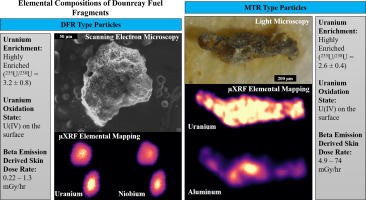当前位置:
X-MOL 学术
›
Sci. Total Environ.
›
论文详情
Our official English website, www.x-mol.net, welcomes your
feedback! (Note: you will need to create a separate account there.)
Characterization of radioactive particles from the Dounreay nuclear reprocessing facility.
Science of the Total Environment ( IF 8.2 ) Pub Date : 2020-04-07 , DOI: 10.1016/j.scitotenv.2020.138488 Ian Byrnes 1 , Ole Christian Lind 1 , Elisabeth Lindbo Hansen 2 , Koen Janssens 3 , Brit Salbu 1
Science of the Total Environment ( IF 8.2 ) Pub Date : 2020-04-07 , DOI: 10.1016/j.scitotenv.2020.138488 Ian Byrnes 1 , Ole Christian Lind 1 , Elisabeth Lindbo Hansen 2 , Koen Janssens 3 , Brit Salbu 1
Affiliation

|
Radioactive particles originating from nuclear fuel reprocessing at the United Kingdom Atomic Energy Authority's Dounreay Facility were inadvertently released to the environment in the late 1950s to 1970s and have subsequently been found on site grounds and local beaches. Previous assessments of risk associated with encountering a particle have been based on conservative assumptions related to particle composition and speciation. To reduce uncertainties associated with environmental impact assessments from Dounreay particles, further characterization is relevant. Results of particles available for this study showed variation between Dounreay Fast Reactor (DFR) and Materials Test Reactor (MTR) particles, reflecting differences in fuel design, release scenarios, and subsequent environmental influence. Analyses of DFR particles showed they are small (100-300 μm) and contain spatially correlated U and Nb. Molybdenum, part of the DFR fuel, was identified at atomic concentrations below 1%. Based on SR-based micrometer-scale X-ray Absorption Near Edge Structure spectroscopy (μ-XANES), U may be present as U(IV), and, based on a measured Nb/U atom ratio of ~2, stoichiometric considerations are commensurable with the presence of UNb2O7. The MTR particles were larger (740-2000 μm) and contained U and Al inhomogeneously distributed. Neodymium (Nd) was identified in atomic concentrations of around 1-2%, suggesting it was part of the fuel design. The presence of U(IV) in MTR particles, as indicated by μ-XANES analysis, may be related to oxidation of particle surfaces, as could be expected due to corrosion of UAlx fuel particles in air. High 235U/238U atom ratios in individual DFR (3.2 ± 0.8) and MTR (2.6 ± 0.4) particles reflected the presence of highly enriched uranium. The DFR particles featured lower 137Cs activity levels (2.00-9.58 kBq/particle) than the MTR (43.2-641 kBq 137Cs/particle) particles. The activities of the dose contributing radionuclides 90Sr/90Y were proportional to 137Cs (90Sr/137Cs activity ratio ≈ 0.8) and particle activities were roughly proportional to the size. Based on direct beta measurements, gamma spectrometry, and the VARSKIN6 model, contact dose rates were calculated to be approximately 74 mGy/h for the highest activity MTR particle, in agreement with previously published estimates.
中文翻译:

来自Dounreay核后处理设施的放射性粒子的表征。
1950年代末至1970年代末,来自英国原子能管理局杜恩工厂的核燃料后处理的放射性粒子无意中释放到环境中,随后在现场和当地海滩上被发现。先前与遇到粒子有关的风险评估是基于与粒子组成和形态有关的保守假设。为了减少与来自Dounreay颗粒的环境影响评估相关的不确定性,进一步表征是重要的。可用于这项研究的颗粒结果表明,Dounreay快速反应堆(DFR)和材料测试反应堆(MTR)颗粒之间存在差异,反映了燃料设计,排放情景和随后的环境影响方面的差异。对DFR颗粒的分析表明它们很小(100-300μm),并且含有与空间相关的U和Nb。钼是DFR燃料的一部分,其原子浓度低于1%。基于基于SR的微米级X射线近边缘结构吸收光谱(μ-XANES),U可能以U(IV)的形式存在,并且基于测得的〜2的Nb / U原子比,化学计量是与UNb2O7的存在相当。MTR颗粒较大(740-2000μm),并且含有不均匀分布的U和Al。钕(Nd)的原子浓度约为1-2%,这表明它是燃料设计的一部分。μ-XANES分析表明,MTR颗粒中U(IV)的存在可能与颗粒表面的氧化有关,这可能是由于UAlx燃料颗粒在空气中被腐蚀所预期的。单个DFR(3.2±0.8)和MTR(2.6±0.4)颗粒中较高的235U / 238U原子比反映了高浓缩铀的存在。DFR颗粒的137Cs活性水平(2.00-9.58 kBq /颗粒)低于MTR(43.2-641 kBq 137Cs /颗粒)颗粒。剂量贡献放射性核素90Sr / 90Y的活度与137Cs成正比(90Sr / 137Cs活度比≈0.8),粒子活度与粒径成正比。根据直接的beta测量,伽马能谱法和VARSKIN6模型,对于活性最高的MTR颗粒,接触剂量率经计算约为74 mGy / h,与先前发表的估计一致。DFR颗粒的137Cs活性水平(2.00-9.58 kBq /颗粒)低于MTR(43.2-641 kBq 137Cs /颗粒)颗粒。剂量贡献放射性核素90Sr / 90Y的活度与137Cs成正比(90Sr / 137Cs活度比≈0.8),粒子活度与粒径成正比。根据直接的beta测量,伽马能谱法和VARSKIN6模型,对于活性最高的MTR颗粒,接触剂量率经计算约为74 mGy / h,与先前发表的估计一致。DFR颗粒的137Cs活性水平(2.00-9.58 kBq /颗粒)低于MTR(43.2-641 kBq 137Cs /颗粒)颗粒。剂量贡献放射性核素90Sr / 90Y的活度与137Cs成正比(90Sr / 137Cs活度比≈0.8),粒子活度与粒径成正比。根据直接的beta测量,伽马能谱法和VARSKIN6模型,对于活性最高的MTR颗粒,接触剂量率经计算约为74 mGy / h,与先前发表的估计一致。
更新日期:2020-04-08
中文翻译:

来自Dounreay核后处理设施的放射性粒子的表征。
1950年代末至1970年代末,来自英国原子能管理局杜恩工厂的核燃料后处理的放射性粒子无意中释放到环境中,随后在现场和当地海滩上被发现。先前与遇到粒子有关的风险评估是基于与粒子组成和形态有关的保守假设。为了减少与来自Dounreay颗粒的环境影响评估相关的不确定性,进一步表征是重要的。可用于这项研究的颗粒结果表明,Dounreay快速反应堆(DFR)和材料测试反应堆(MTR)颗粒之间存在差异,反映了燃料设计,排放情景和随后的环境影响方面的差异。对DFR颗粒的分析表明它们很小(100-300μm),并且含有与空间相关的U和Nb。钼是DFR燃料的一部分,其原子浓度低于1%。基于基于SR的微米级X射线近边缘结构吸收光谱(μ-XANES),U可能以U(IV)的形式存在,并且基于测得的〜2的Nb / U原子比,化学计量是与UNb2O7的存在相当。MTR颗粒较大(740-2000μm),并且含有不均匀分布的U和Al。钕(Nd)的原子浓度约为1-2%,这表明它是燃料设计的一部分。μ-XANES分析表明,MTR颗粒中U(IV)的存在可能与颗粒表面的氧化有关,这可能是由于UAlx燃料颗粒在空气中被腐蚀所预期的。单个DFR(3.2±0.8)和MTR(2.6±0.4)颗粒中较高的235U / 238U原子比反映了高浓缩铀的存在。DFR颗粒的137Cs活性水平(2.00-9.58 kBq /颗粒)低于MTR(43.2-641 kBq 137Cs /颗粒)颗粒。剂量贡献放射性核素90Sr / 90Y的活度与137Cs成正比(90Sr / 137Cs活度比≈0.8),粒子活度与粒径成正比。根据直接的beta测量,伽马能谱法和VARSKIN6模型,对于活性最高的MTR颗粒,接触剂量率经计算约为74 mGy / h,与先前发表的估计一致。DFR颗粒的137Cs活性水平(2.00-9.58 kBq /颗粒)低于MTR(43.2-641 kBq 137Cs /颗粒)颗粒。剂量贡献放射性核素90Sr / 90Y的活度与137Cs成正比(90Sr / 137Cs活度比≈0.8),粒子活度与粒径成正比。根据直接的beta测量,伽马能谱法和VARSKIN6模型,对于活性最高的MTR颗粒,接触剂量率经计算约为74 mGy / h,与先前发表的估计一致。DFR颗粒的137Cs活性水平(2.00-9.58 kBq /颗粒)低于MTR(43.2-641 kBq 137Cs /颗粒)颗粒。剂量贡献放射性核素90Sr / 90Y的活度与137Cs成正比(90Sr / 137Cs活度比≈0.8),粒子活度与粒径成正比。根据直接的beta测量,伽马能谱法和VARSKIN6模型,对于活性最高的MTR颗粒,接触剂量率经计算约为74 mGy / h,与先前发表的估计一致。









































 京公网安备 11010802027423号
京公网安备 11010802027423号